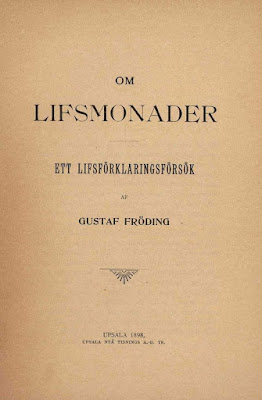In the introduction to The Philosopher´s Stone,
Swedish esotericist Henry T. Laurency writes: ”There exists a vast literature
of which, amazingly, the general public appears to be entirely ignorant.” That
this statement also includes most academic scholars becomes very obvious when
reading Gustaf Fröding – och jag (Gustaf Fröding – and I) by the author Rolf Erik Solheim. This is a pioneering work about the famous Swedish poet, an in-depth
study of the lifeview and worldview of Fröding and how it relates to ideas in
The Esoteric Tradition.
Rolf Erik Solheim is a Norwegian engineer (M.Sc.),
writer and lecturer who, besides his interest in natural science and
technology, for many years has been deeply fascinated by esotericism in literature.
When in the Spring of 2013 he, at a hotel in Värmland, found the book Frödings
mystik (Fröding`s Mystique) by Olle Holmberg, Solheim ”borrowed” this volume
and it was the beginning of a long journey of discovery. Very early on in his
research Solheim realized that almost no writer or academic scholar had studied
the worldview of Fröding, nor had any understanding of its foundation and
sources. Solheim regularly update his findings at the website, Framtiden är din
(The Future Is Yours) created together with his wife Anne.
Rolf Erik Solheim during a lecture at Kristinehamn Public Library October 8, 2016
In 2016 Solheim published a summary of his research
in the yearbook of the Gustaf Fröding Society now later extended in the latest
work Gustaf Fröding – And I. The title has been changed several times as the
author also wished to include how his own spiritual search has been affected by
this study: ”The journey with Fröding is also a personal journey where I narrate
how I wrote the book and how the established Fröding scholars regarded my
project almost as a molestation of the mainstream view of Fröding.” (p. 19)
Since the Olle Holmberg study, published in 1921, no in-depth study has been
made of Fröding´s esoteric worldview. Solheim found out the hard way that all writers
including academic scholars are metaphysical illiterates. Hopefully this will
change because of the renaissance of academic interest in the once taboo subject
Western Esotericism. It is slowly been recognized that The Esoteric Tradition
is the third intellectual force or pillar in cultural history besides religion
and science.
Yerbook of the Gustaf Fröding Society 2016
Gustaf Fröding spent the latter part of his tragic life
at different mental institutions and hospitals. His most precious possession
during these final years was a portrait of Goethe. His friend, poet Erik Axel
Karlfeldt, visited Fröding and noted: ”Goethe´s ´Geist´ was to Fröding
something much more than spirit in the ordinary sense, an all-consciousness. In
his Graal poetry the Divine Spark, which according to Fröding exist in every
human being, is connected to this all-consciousness.” (p. 46). This deep attachment
to Goethe reveal a spiritual affinity as Goethe was a member of the secret
Rosicrucian fraternity which he disguised as The Fellowship in the Tower in his
second novel Wilhelm Meister´s Apprenticeship.
Gustaf Fröding 1910
An important discovery was made by Solheim in the
Fröding archive at Uppsala University Library. Among the 133 volumes many are
filled with notes and comments by Fröding himself, especially in the collected
works of philologist and Orientalist Max Müller. The comments give many clues
to Fröding´s worldview and spiritual quest. When Solheim found these comments
he took no less than 600 pictures as reference to his book. Of interest is that
one book in the Fröding archive is the Swedish edition of Theosophist Alfred
Percy Sinnett´s Esoteric Buddhism.
Gustaf Fröding wrote three small booklets presenting
his worldview. The most important bears the title Om lifsmonader. Ett lifsförklaringsförsök
(On Life Monads. An attempt to Explain Life), privately published in 1898. The idea
of the evolution of consciousness that Fröding tried to formulate in his
booklets was usually misunderstood or completely ignored by later scholars and
writers, revealing their ignorance of The Esoteric Tradition. Solheim give many
examples from literary reviews and books how mainstream academics viewed these
works, often referring to Fröding´s mental illness: ”balmy”, ”a curiosity”, ”hocus
pocus”, ”reduced capacity for reasoning power”, ”a low point in Fröding´s
production” etc.
A major part of the book consists of Solheim´s
quotes and references to various historical and contemporary authors who from
different viewpoints discuss the same ideas and problems as Fröding. Here we
find Plato, Pythagoras, Leibnitz, Goethe as well as Roger Penrose and Max Tegmark.
But there is also a few quotes from esotericists Roberto Assagioli and Henry T. Laurency. This may be a bit confusing to the reader as there is no summary of
the basic ideas in the core Esoteric Tradition – Helena P. Blavatsky, Alice
Bailey, Henry T. Laurency. Italian psychiatrist Roberto Assagioli was the
founder of Psychosynthesis but also secretly a disciple of the Tibetan adept
who dictated the works published by Alice Bailey. Regarding his connection to
the Tibetan, Assagioli kept a strict ”wall of silence”.
Three pages are devoted to Pythagoras and hylozoics
with some short comments on the writings of the erudite Swedish esotericist
Henry T. Laurency. To fully understand the unique contribution of Laurency to
esoteric philosophy, a more extensive chapter should have been included. Especially
as Solheim recognize Laurency as an expert esotericist: ”If Fröding had known
that the worlds foremost monad thinker a few years after his death would study
philosophy at Uppsala University he had possibly asked the All-Consciousness
permission to live a few more years to meet him.” (p. 208). Henry T. Laurency
studied philosophy at Uppsala University in the beginning of the 20th century.
Together with the author at Kristinehamn Public Library 2016



